Reflections over the Rhine
 By MIKE PASINI
By MIKE PASINI
Editor
The Imaging Resource Digital Photography Newsletter
We crossed the Rhine River on the Bensberg tram every morning during our stay in Cologne to cover photokina 2006. And we came back late in the afternoon over the same route on the Weiden West tram. Unable to eavesdrop in German, the daily commute provided a chance for some reflection on what we'd seen at the show.
While we spent the evenings compiling our show reports (http://www.imaging-resource.com/EVENTS/PKNA06/PKNA06.HTML) with Web galleries and getting the last issue of the newsletter out to you, we thought we'd skip the usual product recap to focus on some interesting trends.
TRADE SHOWS | Back to Contents
The fate of the trade show in the century of the Internet has been far from certain. Seybold has given up the ghost, Apple (having invested in storefronts) pulled out of Macworld Expo Boston in 2005, which led to the cancellation of that classic and even the Photo Marketing Association Convention and Trade Show has seen a decline in visitors and exhibitors as the Consumer Electronics Show demands more attention.
But every two years, Cologne hosts photokina. It's the largest gathering of exhibitors in the imaging business, covering everything from cameras to photobooks, from lighting gear to frames, from camera clubs to contract negotiations. The business end of the exhibit is its spine, though, providing a rare chance to conduct face-to-face negotiations for many companies. That's not going away.
For the end user, this edition offered a chance to handle a company's entire product line (from Agfa to Voigtlander). The 10-building concourse organized the show along a workflow theme, covering input equipment, image processing, image storage, accessories and consumables, presentation and output services. Our daily show reports mimicked that organization, in fact.
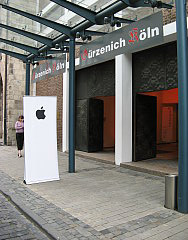
Apple Event. The night before photokina opened, Apple revealed Aperture 1.5 here.
There were reportedly some 6,000 journalists covering photokina this year. Getting their attention is, apparently, an increasingly difficult task, given the large number of exhibitors. Consequently some very big news was pre-announced with both Canon and Nikon introducing new and affordable dSLRs and Apple announcing an Aperture update the night before the show to a red-eyed but large crowd in the city's center.
Will there be another photokina? we wondered as we zipped across the floor, like the rushing leader among journalists, on our way to one or another exhibit. The buzz in the air was electric, we observed. A few blockbuster shows like CES and photokina still seem to be irresistible. Whatever else happens, bet on photokina 2008.
Being able to handle any company's entire product line is a thrill for any consumer. But it's something of a poisoned apple for a journalist. And being the only one of our crew assigned to write a report (with the more photogenic staff wrapped in video production), the task of seeing everything was beyond even the miseries of Hercules (who also didn't speak German).
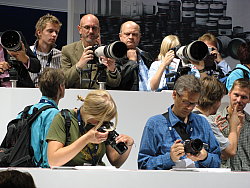
Canon Crowd. Trying out the line-up.
We did, however, take our usual stroll through the show to get a feel for what was going on. And we were struck by the enormous and enthusiastic crowds, primarily packing the camera manufacturers' exhibits, which were themselves the largest we'd seen, often encompassing small studios and mini theaters where fans could raise their cameras to shoot attractive models swathed in dry ice, iridescent cosmetics and other accouterments of the theatrical arts.
Leica Lovers. Trying out the line-up -- in appropriate attire.
Being the disappointed owner of an Average digicam, a Nameless printer and driving a humble Rumbolino, we can't be accused of favoritism to any particular brand. But that isn't true, we've seen over and over again, of most camera owners. Like everyone else in this business, we're asked for camera recommendations. We know you can't go wrong with any of the current models. And we fall in love with a new one every week, too, so we always have a recommendation.
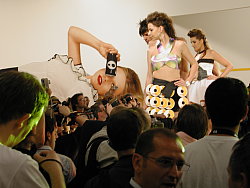
Kodak Carousel. Even the graphics took shots.
But we've learned it rarely matters what we say. If you've owned a Canon, you'll buy a Canon. If you've owned an Olympus, you'll buy an Olympus. So we always ask, "What are you using now?"
And what we saw at photokina certainly did nothing to dissuade us from that approach. We found it very amusing to go from the Canon crowd to the Leica lovers, shooting not just the merchandise but the buyers. Each group seemed ready to paint their faces and cheer for their favorite company as they admired the new gear.
Brand loyalty may break down, however, when it comes to printers. Epson and Hewlett Packard printer fans, clearly, own all sorts of cameras. Even the Canon printer club, clearly, includes Nikon owners. And none of them likes buying the company's inks or papers!
CAMERAS, PRINTERS | Back to Contents
The dSLR has been around long enough that buyers are aware of its problems. Like sensor cleaning. We were surprised to see so many new dSLRs following up on Olympus' lead in automatic sensor cleaning. It was, for many, a simple extension of their following up on Konica Minolta's in-camera image stabilization, shaking the sensor on start-up. And anti-static coating on the sensor glass is another feature routinely included, although we wonder what happens when you swab it.
Image stabilization is a very big deal, providing two to three stops more handheld possibilities and nearly relegating flash to the dust bin of history. It's a big deal in digicams because it provides more natural scene rendering than a digicam flash can. But it's also important in a dSLR.
Leica M8. A rangefinder with Adobe NDG.
There are two ways to get image stabilization in a dSLR: with an image stabilized lens having a wide range of focal lengths (like an 18-200mm lens) or with in-camera image stabilization, which turns every lens you own into an image stabilized lens. The alternatives have slightly different characteristics, but the benefit is undeniable.
Of course, we live in an autofocus age. The pleasure of twisting a focusing ring slowly until one subject or another comes into focus is lost to many. So having in-camera image stabilization may not be the great boon it at first seems like if you are buying new autofocussing glass anyway.
Leica seems to have thought about this more than most, offering a simple lens conversion so M-series owners can use their 1954 glass on the new M8 digital rangefinder (that would be a dRF, presumably). This isn't an autofocussing crowd, but having the lens data electronically available to the M8 is worth the trouble of converting. That data ends up in the M8's Raw format image file, which interestingly enough turns out to be Adobe's Digital Negative format.
We got our hands on both a film M7 and the dRF M8 and found the experience remarkably similar. In fact, the bottom of the M8 opens just like the M7, but instead of replacing film, you are accessing the battery and flash memory compartment. Focusing with a large bright viewfinder that does not rely on the lens to render the frame was a relief to our eyes and the smooth and silent focusing mechanism was such a joy to use we nearly beeped when we found focus.
The odd mix of rangefinder heritage and DNG file format made the M8 the most remarkable camera of the show for us.
IMAGE PROCESSING | Back to Contents
Nothing slows the evolution of imaging software. Nothing. It's little covered in the hardware-centric world of imaging enthusiasts, but every printed image has to go through it one way or another. It's central. And it's also a real celebration of human ingenuity.
Unfortunately, it gets a lot of rotten tomatoes tossed in its direction, too, as users bemoan one or another design choice or direction the developers trek toward.
Early adopters of the Raw format quickly organized into nearly-armed camps around Adobe Camera Raw (and now Bridge), Rawshooter (subsequently bought by Adobe), Camera One, Bibble and a few other programs whose job was to optimize Raw images.
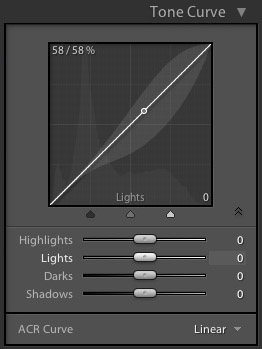
Lightroom's Curves. Use the sliders to affect a part of the curve and mind the bubble on the axis for credible changes.
But those early efforts all required intricate workflow solutions to integrate them into the game. That spawned books, lectures and PDFs on the various options photographers have to employ this stuff without wishing for a world of film and pro labs again to restore some productivity.
Then Apple addressed the workflow issue in a more comprehensive way with Aperture. And Adobe followed quickly by releasing a public beta of its equivalent, Lightroom. These two applications were both on display at photokina in new releases. Aperture 1.5 finally opened its catalog up and Lightroom beta 4 continued its evolution by taking the mystery out of the Curve command.
But what isn't always appreciated about this evolution is the changing nature of image editing. One practitioner calls it metadata editing vs. pixel editing -- and that about sums it up.
The problem is that you return from an event or a shoot with more images than you can reasonably Photoshop. You can't open each image, apply some filters, save and move on to the next image, one by one, changing the pixel data in each file and still get the job done on time.
The solution is to shoot Raw and make edits to the metadata that can be applied to a set of similar images. The metadata stores these changes (including even crops) without ever touching the pixel data. This is not only infinitely faster, it's non-destructive. The original data is always available. And you can batch process your shoot into derivative JPEGS for print or the Web.
While this approach seems like a godsend for people who shoot a lot of images (like journalists and event photographers), it's not a comfortable box for others (like artists or studio photographers) who focus on a few select images. Hence the rotten tomatoes.
But these new tools are not going away and watching them evolve with developers relying on user feedback is fascinating.
LENS CORRECTION | Back to Contents
There's nothing quite like slrgear.com (http://www.slrgear.com), as a few people reminded us at the show. Everybody is swamped keeping up with the new cameras, a few are chasing the new printers, fewer still the newest scanners. But Imaging Resource has taken on lenses and accessories, too. And the lenses are plenty of work all by themselves.
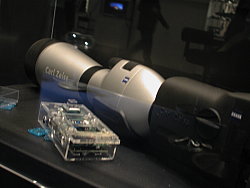
Zeiss scope. With DxO corrections built in.
But you buy a dSLR for the system, really. The lens and accessory system is what makes the experience, bodies coming and going. And slrgear.com addresses that with graphs that show exactly how any tested lens performs.
The site uses DxO's software to profile a lens throughout its range of focal lengths and f-stops. And for a long time, DxO had no competitors. But in the evolving world of software solutions, that day is over.
Prolex Software (http://proxel.se), which did not exhibit at photokina, has just released its Windows-only Lens Corrector Photoshop plug-in. But at the show, we spent some time with Nurizen's Sebastian Schroder, who wrote Acolens (http://www.acolens.com), a Mac application that corrects optical distortion, vignetting and corner softness by profiling a lens.
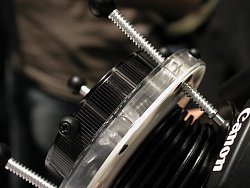
Lenbaby 3. Ingeniously holds position.
These systems are intended for dSLR lenses (and priced that way), but it's possible to use them to profile digicam lenses, too. That could be a business opportunity because it sounds like work to us.
The human mind easily accommodates distortion except when the focus of attention is a face on the edge of the frame that has been spread wide by lens distortion. These tools can correct for that automatically. And by marrying the software correction to the glass, they promise some interesting optics for the future. DxO, for example, has already put their smarts into a Zeiss scope.
Distortion isn't always a bad thing if you talk to the Lensbaby guys. Their booth was packed with people intrigued by the new version of this selective focus lens which can now hold its position. We published close-up photos of the mechanism in our show report.
FLASH TECHNOLOGY | Back to Contents
Those marriages between hardware and software can also get a little strained, though. We visited with DataRescue's Pierre Vandevenne, the wizard behind PhotoRescue and learned a bit more than we wanted to know about keeping up with flash technology to recover lost image files.
It seems the new higher-capacity cards require new readers. Pop a 4-GB or 8-GB card into your old reader and your operating system offers to initialize it for you. Don't go there.

Pierre
Pierre noticed we were shooting the show with a digicam of the last century and confessed his affection for old digicams. He has a Nikon 950 himself and boasted that even his 2-Mp digicam takes better pictures than some of these modern wonders with tightly packed sensors that create a lot of noise. He also pointed out Nikon made a rounding error in the firmware that will zap your card if you fill it. Modern cameras (and cards) understate card capacity a bit to protect you.
He demonstrated by setting his Canon to Raw mode and popping in a card small enough to accommodate a couple or three Raw images. But the camera reported the card was out of memory.
Then he popped another card in a reader and used PhotoRescue to check the card, showing errors at the end of the card, which is fortunately little used (and why card capacity is under measured). That's another problem itself, since flash memory is subject to wear level -- you can only write to it so many times and if you write to just the beginning of the card over and over, that will cause some cards to fail sooner than they might if you had regularly used more of the card).
While there's certainly a market for in-house large format printing by individual photographers, the technology is mostly of interest to us for what it portends to the inkjet market in general. That's usually expressed in media (both ink sets and paper), but sometimes there are other interesting features.
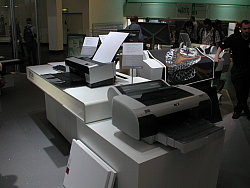
Epson. The 3800 and 4800 in the print lab.
Hewlett-Packard's Z line follows the introduction at PMA of its B9180, a pigment-based inkjet that uses a densitometer to calibrate the printer. The Z line goes one better with a spectrophotometer to read targets printed by the printer on any medium you want and quickly create an ICC color profile. And you can tweak those profiles to what looks good to you, a feature HP described as "democratizing color."
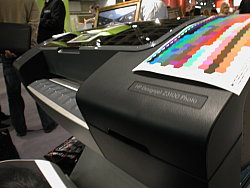
HP. A Z3100 and color target 'democratizing' color.
That sounds like a competitive advantage to us. Two photographers could buy the same printer and tweak it to deliver completely different results. Reliably.
And there are differences to milk with the the 12-ink Z3100 especially, which according to HP, has the largest color gamut of any inkjet printer yet. Both printers use Vivera pigment ink (like the D9180), featuring 200+ year permanence (vs. the Epson K3 set's 150-170). But while the eight ink set of the Z2100 is comparable to the K3's color gamut, the Z3100's 12 inks surpass it.
THE REST OF US | Back to Contents
One advantage the reporter has over the consumer is that these trade shows never squeeze the wallet, just the review schedule. So we were fascinated to learn at IDC's presentation of its Consumer Imaging Survey what it really means to buy a digital camera these days if you live in Germany, the Czech Republic or Russia.
First the good news. You'll pay the same for a 10-Mp digicam today as you would have paid for a 3-Mp digicam three years ago. And buyers still look at megapixels above all, IDC found. Zoom range, image stabilization (you've been listening!), LCD screen size, optical viewfinder, startup/shutdown time and weight are also on your mind when you compare cameras.
The decision to buy or upgrade your digicam in Germany, where the average monthly wage is $3,390, means spending 9.6 percent of that monthly income. But in the Czech Republic, where the average monthly take is $787, it means parting with 35.6 percent of that month's pay. If you happen to live in Russia, with just $300 a month coming in, you have some serious budgeting to do, with a digicam costing 111 percent of your monthly income. Not a good place to work on commission.
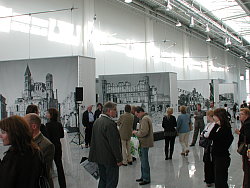
Sixty Years of Peace. Stunning canvas prints from scanned 8x10 glass negatives exposed in the 1940s.
In the end, it's all about the images, which require no translation. The show had plenty of galleries, but right next to the press room we couldn't miss "Sixty Years of Peace," an exhibit of post-war photos by the late architectural photographer Karl Hugo Schmolz. He lugged his 8x10 view camera around the city after World War II, shooting the bombed out city hall, opera house and other landmarks of Cologne before the rubble of former glory was carted away forever. His glass negatives were recently scanned and printed on huge, 40-square-meter canvases that were simply stunning in their detail.
We asked Jean Mohring, the director of the German-Dutch Society that was a sponsor of the exhibition, what these images of destruction had to do with 60 years of peace. "Churchill did us a favor," Jean told us. "He said, 'Destroy everything but the cathedral.'" Now Cologne wants to spread the message that peace is a good thing. "Look at this rubble," he warned, "and be careful. Be friends."
Crossing the Rhine for the last time, we reflected on Jean's words. Photography is a silent medium, but what it has to say can be heard very clearly even over the din of one camp or another. All you have to do is snap the shutter.